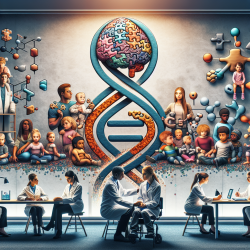Introduction
As professionals dedicated to enhancing the lives of children with developmental challenges, staying abreast of the latest research is crucial. The study titled "The epilepsy phenotype of ST3GAL3-related developmental and epileptic encephalopathy" provides valuable insights into a rare genetic condition that impacts cognitive and motor functions. This blog aims to distill key findings from this research and suggest practical ways for practitioners to apply these insights in clinical settings.
Understanding ST3GAL3-Related Developmental and Epileptic Encephalopathy
ST3GAL3-related developmental and epileptic encephalopathy (DEE-15) is an autosomal recessive condition marked by intellectual disability, language and motor impairments, behavioral difficulties, and epilepsy. The research conducted by Whitney et al. (2023) highlights the epilepsy phenotype associated with this condition, which is characterized by early-onset seizures, often presenting as epileptic spasms.
The study involved a retrospective chart review of two siblings with ST3GAL3-related DEE and a literature review of 24 cases. Key findings include:
- Seizures typically begin in infancy, with a median onset age of 5.5 months.
- Epileptic spasms are the most common seizure type, occurring in 67% of cases.
- Despite treatment, 75% of children continued to experience seizures.
- Prolonged seizure freedom was achieved with carbamazepine in some cases.
- Tremor may be a unique feature of this condition.
Implications for Practitioners
Understanding the specific phenotype of ST3GAL3-related DEE can significantly enhance the diagnostic and therapeutic approaches for affected children. Here are some practical steps practitioners can take:
- Early Diagnosis: Given the early onset of seizures, early genetic testing and diagnosis can facilitate timely intervention. Practitioners should consider genetic counseling for families to understand the inheritance patterns and implications.
- Tailored Treatment Plans: While traditional anti-seizure medications may not always be effective, carbamazepine has shown promise in achieving prolonged seizure freedom. Practitioners should remain open to adjusting treatment plans based on individual responses.
- Comprehensive Care: Addressing the broader developmental and behavioral challenges associated with ST3GAL3-related DEE is essential. Collaborating with speech-language pathologists, occupational therapists, and other specialists can provide holistic care.
- Research and Collaboration: Encourage participation in ongoing research and clinical trials to explore new therapeutic avenues. Collaboration with geneticists and neurologists can enhance understanding and treatment outcomes.
Encouraging Further Research
While the study by Whitney et al. provides significant insights, the rarity of ST3GAL3-related DEE means that many questions remain unanswered. Practitioners are encouraged to contribute to research efforts by documenting and sharing clinical experiences. This collective knowledge can pave the way for more effective interventions and improved outcomes for children with this condition.
Conclusion
The research on ST3GAL3-related developmental and epileptic encephalopathy underscores the importance of genetic insights in managing complex neurological conditions. By integrating these findings into clinical practice, practitioners can enhance their skills and contribute to better outcomes for affected children. To delve deeper into the research, please read the original paper: The epilepsy phenotype of ST3GAL3-related developmental and epileptic encephalopathy.










